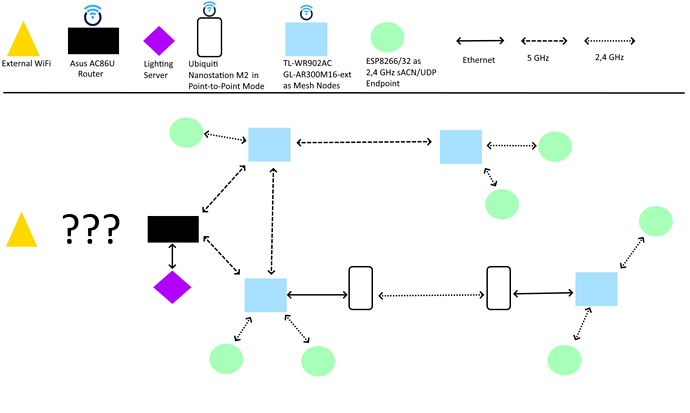Hi there,
I am tinkering on my network infrastructure for different purposes, mainly to connect a variety (20+) of LED fixtures running ESPs for my lighting installations at festivals, open airs and other possible events. As I dont know what the future locations will be like, I try to be as flexible as possible and prepare my rig for all kind of situations.
- Runs on power banks if no AC is available
- Larger distances will be bridged via Point-to-Point(Multipoint) connections
- Mesh via B.A.T.M.A.N-adv on OpenWRT using 5 GHz
- Controlling server, router and LED fixtures through WiFi from all covered areas
- Can be used as infrastructure network for the events (e.g. for connecting smartphone based paying and ticket systems)
- Also suitable for indoor installations
- Easily expandable
- Low latency > Bandwidth
My current plan:
As I am looking for the Jack-of-all-Trades, I could need some advice regarding the setup:
-
How do I get Internet into my network from an external WiFi source?
a) Use the 2,4GHz radio of the ASUS router to connect as a wifi client
b) Use one of the mesh node devices as a wifi client to deliver internet via Ethernet to the WAN port of the AC86U
c) Use a P-to-P device instead of a mesh node device (better radio?)
d) Addionatly connect one device to the external router via ethernet (if possible) and WDS (?) -
I like to keep my 5V travel routers (TP-Link TL-WR902AC, GL-iNET GL-AR300M16-Ext) as mesh nodes, but are there other "better" small devices around 30 Euro that I should take into account?
-
Should I go for one dedicated model for the mesh nodes or is mixing hardware ok (taken that they work in general)?
-
Is integrating P-to-P (or P-to-MP) connections/devices a problem?
-
Any other tips, experiences or recommendations regarding the architecture you can share?
Thanks
Kelvin - Kandela Lighting
